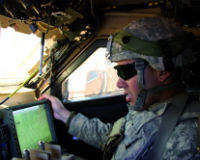
Enhancements in precision, long-range munitions and improved intelligence, surveillance and reconnaissance (ISR) technologies have deceived some into believing that nations don’t need to focus on tactical ground forces.
However, despite the marvels of innovative technologies of ‘fire and forget’ missiles and unmanned aerial systems (UAS) that allow remote-control combat, countries need to have a presence on the ground to effectively control lines of communication and set the conditions for success.

Discover B2B Marketing That Performs
Combine business intelligence and editorial excellence to reach engaged professionals across 36 leading media platforms.
Asymmetric threats, such as improvised explosive devices (IEDs), have become a prominent threat to counter the technology overmatch that many nations have developed. As a result, the need to balance protection and mobility – both tactical and strategic – has become more tenuous. This is further exacerbated by the growing costs for research and development as well as ever-increasing prices for maintenance and sustainment.
Tactical mobility in this context means drivetrain, speed, manoeuvrability (on and off improved roads) and the ability to accomplish tight turns in complex terrain. Strategic mobility in this context is reduction in weight and cubic volume to be able to transport tactical vehicles rapidly by air or sea in the minimum number of sorties.
In addition to balancing protection against mobility, simplifying logistical support and reducing costs, a critical aspect of survivability and performance for armoured vehicles is integration into the network: the ability to leverage the collective understanding of leaders through sharing situational awareness and a common operating picture.
A culture of networks and digital natives
Just as the networking of computers has transformed how we communicate, access data and conduct commerce over the last 20 years, effective networking of tactical vehicles is transforming the way we carry out combat operations and other missions. Improvements in on-the-move technology will continue to enhance the effectiveness of armoured vehicles into the future.

US Tariffs are shifting - will you react or anticipate?
Don’t let policy changes catch you off guard. Stay proactive with real-time data and expert analysis.
By GlobalDataSoldiers entering the military today are ‘digital natives’ – they have grown up with computing devices that are networked together. Our culture has trained them to be proficient in accessing and exploiting digital technology. Our view of armoured vehicle improvement needs to leverage this capability to add additional survivability and mission effectiveness. The network is not the solution, but it is an enabler; an enhancement that improves performance.
Information sharing
"For the strength of the pack is the wolf, and the strength of the wolf is the pack," wrote Rudyard Kipling.
Tactical vehicles do not operate alone. Armoured vehicles move with a wingman, as a section, or in small units. They depend on each other for overwatch and security.
Network-enabled vehicles can share information more easily, providing common understanding with a wingman and other elements within a unit, even when separated by complex terrain. Access to sensor data, adjacent units and command nodes on a geo-referenced display provides a more useful, accessible format than just voice communication and a paper map.
Network-enabled combat vehicles give leaders at every level the ability to ‘see’ the battlefield, share critical information and act decisively in the following ways.
- See: friendly situational awareness – know the position of friendly forces in real time, geo-referenced on the terrain, to understand current status and avoid fratricide; visualise reported and actual threat locations to limit risk and to target.
- Share: enable simultaneous view to all vehicles in the network of friendly and enemy locations; leverage the network to ‘cue to target’, enabling reconnaissance elements to pass targets to assault forces seamlessly in real time; disseminate updated mission graphics, target locations and manoeuvre routes simultaneously to every vehicle in the unit, as well as provide images and sensor data to refine targets.
- Act: collaborate over the network in real time; visualise the mission in real time, with running estimates and automated cues to decision points.
Situational understanding gained through networked vehicles can enhance mobility and protection as well as improve mission efficacy and reduce the fog of war. The components of a network enabled system include:
- ruggedised computing hardware
- software with an intuitive user interface that allows vehicle crew members to rapidly access necessary information
- robust, capable, secure network transport that provides rapid access to data.
Network where you need it
One of the biggest challenges to date has been the availability and reliability of the network transport to provide this connectivity within vehicle formations and to command nodes. Line-of-sight data radios require significant network management and have difficulty maintaining linkages across the distances and challenging terrain within which units must operate.
The traditional view of beyond-line-of-sight, satellite networks has been that it is either unaffordable or too slow to be of value. ViaSat’s BFT2 and C2/SA capabilities, for example, provide a high-performance, rugged, secure network that brings the network to armoured units where they need it. Enhancements to the L-band waveform, a high-gain, rugged transceiver, improved ground infrastructure and certified transmission security provide a reliable, affordable and fast solution.
Tactical vehicles add value to dismounted operations through protection, mobility and extending the network. The network connectivity is an enabler, much like training and effective leadership, to enhance mission success.
Empowering soldiers with the information they need, when they need it, in a timely and useful format will improve unit effectiveness.
Digital natives that are entering service in the armed forces today understand the power of connectivity and have a comfort level with digital information exchange.
As we look to the future of tactical formations, providing connectivity will be a combat multiplier that leaders can use to improve performance and mitigate risk.





